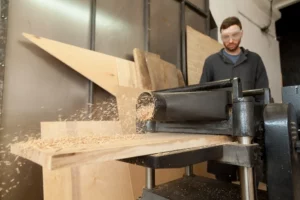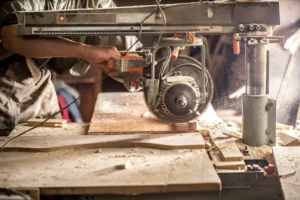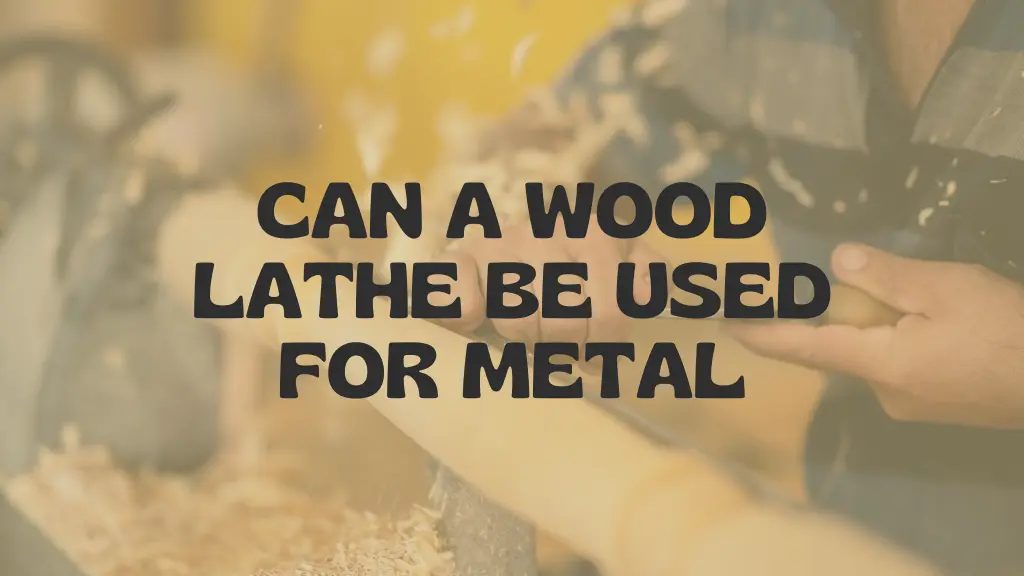Describe how can a wood lathe be used for metal with techniques and considerations. Explore the techniques and challenges of using a wood lathe for metal turning.
Can a Wood Lathe be used for Metal?

Wood lathes are mostly designed for woodworking and are converted in different shapes for handling wood’s characteristics, such as lower torque and higher spindle RPM. Because of these limited facilities, they are a little less than ideal for metalworking.
Important factors for the use of wood lathes for metalwork are:
- Torque and RPM: Wood lathes always operate at very high RPM with relatively low torque, whereas metal lathes are designed with higher torque and lower RPM to accommodate the metalwork. In contrast, metal lathes provide the strength and precision needed to cut, drill, and mill harder materials like steel and aluminum.
- Insufficient Cutting Force: Wood lathes, with their hand-held tools, may lack the necessary force to efficiently cut and shape metal surfaces. Wood lathes, with their hand-held tools, may lack the necessary force to efficiently cut and shape metal surfaces.
- Heat and Friction: Hard and porous metals cannot withstand high-speed rotations on a wood lathe without overheating. This can lead to surface damage, warping, or even tool failure during operation. Proper cooling systems and lower RPMs are essential for safely machining metal components.
How to Use a wood lathe for metal
A specific woodworking technique where the workpiece is all time rotated against a stationary cutter, all these techniques be performed on a metal lathe with minor changes:
Workpiece Placement: Place the object of your piece on the metal lathe, similar to how it’s done on a wood lathe.
- Profile Tracing: Trace the desired profile on the workpiece, maintaining consistency with standard woodturning practices.
- Speed Adjustment: Gradually increase the lathes’ speed to match your specific woodturning requirements.
- Surface Smoothening: After shaping the object, you may need to sandpaper the workpiece to achieve a smooth finish, as a result, metal lathes may be a rougher place when used for woodturning.
- Post-Operation Cleaning: All the time when making the project clean the metal lathe to prevent wood dust and shavings from accumulating and potentially causing damage to the machine’s components.
Tips and Techniques for Using a Wood Lathe for Metal

So, here we are explaining some tips and techniques for using a wood lathe for metalworking:
- Update the Tool Rest: So, replace the standard wood lathe tool rest with a strong metal lathe tool rest. After applying this step. This will provide a better, stronger and more supportive object when working with metal.
- Adjust the Settings of speed: Sometimes wood lathes have higher RPMs. Then you must lower the speed settings to match the requirements for metalwork.
- Install into a Metal Chuck: To securely hold it, you must replace the wood lathe chuck with a metal chuck. This is essential for metal workpieces in place.
- Speed Steel Tools: All the Traditional woodturning tools won’t be adequate for metalwork. You must invest in high-speed steel tools that are designed for metal turning.
- Implement Friction Reducing Tool: Wood lathes do not produce heat whereas Metal turning generates more heat. Ensure proper friction reduction to save overheating and reduce tool wear.
- Ensure Rigidity: Force the lathe’s structure to handle the additional stress. Sturdy mounts and bracing can help maintain stability during metal turning.
- Safety Precautions: Before starting the project you must Wear appropriate safety gear, including Google eye protection, hearing protection, and gloves. Sometimes Metalwork can produce sparks and chips, which can be hazardous.
- Practice: when you are transitioning from wood lathes to metal on a lathe that may require a learning curve. You must practice on scrap metal pieces before starting work on important projects.
- On Regular Basis Maintenance: When you convert a wood lathe for metal you must keep it well-maintained regularly. Clean it all when you use it and monitor the cover on components.
Advantages of Using a Wood Lathe for Metalworking
- Variety of Usage: When you decide to choose between a wood lathe and a metal lathe, the wood lathe provides multiple versatility. It can be employed for a broad range of projects, extending beyond woodworking.
- Strongness: Metal lathes are not very strong even Wood lathes are often more robust than metal lathes, providing added support, this can be a more strong advantage for woodworking, particularly when handling large, unsteady, or lengthy workpieces.
- Speed control: Some wood lathes allow for variable speed control. When you enable the setting of rotating speeds to suit specific requirements, including shaping challenging workpieces.
Disadvantages of Using a Wood Lathe for Metalworking
- Limited Correction: Sometimes when you use Wood lathes for metal, they may not achieve the necessary correction for metalworks tasks, So especially when creating smooth surfaces and precise curves. This lack of precision can result in uneven finishes and increased material waste.
- Maintenance Needs: When you are using a wood lathe for metal, all project needs must be clean and swift cleaning is essential to save metal parts and maintain proper friction. Metal shavings and dust can accumulate quickly, causing wear on the machine and reducing accuracy. Regular cleaning also prevents rust buildup and ensures smoother tool movement throughout the project.
Conclusion
All the above information proves that while it’s technically possible to use a wood lathe for metal, it’s far from ideal because wood lathes lack the torque, RPM control, and robust construction that metal lathes offer. Because when we are Using a metal for woodworking is stronger, it may come with limitations in achieving certain woodworking and maintenance.
FAQ’s
- Can any wood lathe be used for metal?
While some wood lathes can be modified for metalworking, not all are suitable. Check your lathe’s specifications and consult the manufacturer for guidance.
- What safety precautions should be taken?
Wear appropriate personal protective equipment, follow operating guidelines, and be aware of potential risks like tool kickback.
- Are there specific metals better suited for wood lathes?
Softer metals like aluminum may be more forgiving on wood lathes, but users should still consider the lathe’s capacity and make necessary adjustments.




